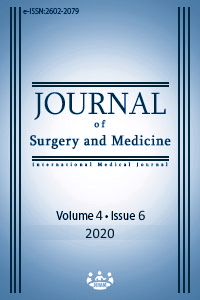The evaluation of calcium as a prognostic factor in non-traumatic cardiopulmonary arrests
Keywords:
Corrected calcium level, Cardiopulmonary resuscitation, PrognosisAbstract
Aim: Cardiopulmonary arrests (CPA) should be rapidly responded to in emergency departments (ED). Arrests associated with coronary cardiac diseases are held responsible for about 90% of sudden mortality over the age of 18 years. In our study, the effect of calcium on prognosis was investigated in patients who were admitted to our emergency department with non-traumatic CPA and underwent cardiopulmonary resuscitation (CPR).
Methods: The data of 132 non-traumatic CPA patients who were admitted to the emergency room between 1 January 2017 and 31 December 2019 were examined from the hospital registry for this cohort study. The demographic features (age, gender, mortality, and the presence of diseases in their medical history) were noted. Blood was collected from patients at the time of admission to the ED. Adjusted serum Ca+2, potassium (K+) and sodium (Na+) electrolyte levels were evaluated among patients who were either admitted to the intensive care unit or died.
Results: Fifty-eight (43.93%) patients died in the emergency department, and 74 (56.07%) were admitted to intensive care units. There were no comorbid diseases in 50.76%. Coronary artery disease, respiratory diseases and others were found in 23.46%, 6.06% and 19.7% of the patients, respectively. In the patient group declared “exitus” in the intensive care unit after CPR, serum adjusted calcium levels were significantly higher compared to the surviving patient group (P=0.041)
Conclusion: It was noted that adjusted Ca+2 concentration can be a beneficial parameter in determining the prognosis in non-traumatic arrest cases.
Downloads
References
Leong BSH. Bystander CPR and Survival. Singapore Medical Journal. 2011 August;52(8):573-5.
Şener S, Yaylacı S. Cardiopulmonary resuscitation and emergency cardiovascular care guideline "Two guidelines and important changes to daily practice". Turk J Emerg Med. 2010;10(4):199-208.
Kozacı N, Oğuzhan Ay M, İçme F, Aktürk A, Satar S. Are We Successful in Cardiopulmonary Resuscitation? Cukurova Medical Journal. 2013;38(4):601-9.
Walker WM. Dying, sudden cardiac death and resuscitation technology. Int Emerg Nurs. 2008 April;16(2):119-26. doi: 10.1016 / j.ienj.2008.01.0075.
Kandiş BH, Boz V, Sarıtaş AM. Çandar M, Baltacı D, Çıkman M. Kardiyopulmoner Resüsitasyon Konusunda Tıp Fakültesi Öğrencilerinin ve Araştırma Görevlilerinin Bilgi ve Beceri Düzeylerinin Geliştirilmesi. Konuralp Medical Journal. 2014;6(3):8-11.
Berek K, Lechleitner P, Luef G, Felber S, Saltuari L, Schinnerl A, et al. Early Determination of Neurological Outcome After Prehospital Cardiopulmonary resuscitation. Stroke. 1995 April;26(4):543-9. doi.org/10.1161/01.STR.26.4.5437.
Santana LF, Gomez AM, Kranias EG, Lederer WJ. Amount of calcium in the sarcoplasmic reticulum: influence on excitation-contraction coupling in heart muscle. Heart Vessels. 1997;Suppl 12:44-9.
Doğan Ö. Total Calcium Levels in Patients with Hypocalcemia Compared to Ionized Calcium and Adjusted Calcium. Journal of Duzce University Health Sciences Institute. 2019 May;9(2):67-70. doi: 10.33631/duzcesbed.547378
Sandroni C, Nolan J, Cavallaro F, Antonelli M. In-hospital cardiac arrest: incidence, prognosis and possible measures to improve survival. Intensive Care Medicine. 2007 Feb;33(2):237-45. doi: 10.1007/s00134-006-0326-z
Hayashi M, Shimizu W, Albert CM. The Spectrum of Epidemiology Underlying Sudden Cardiac Death. Circulation Research. 2015 Jun;116(12):1887–906. doi: 10.1161/CIRCRESAHA.116.304521.
Akahane M, Ogawa T, Koike S, Tanabe S, Horiguchi H, Mizoguchi T, et al. The effects of sex on out-of-hospital cardiac arrest outcomes. The American Journal of Medicine. 2011 April;124(4):325-33. doi.org/10.1016/j.amjmed.2010.10.020
Çakmak S. Hastane Dışı Kardiyak Arrest Geçiren Hastalarda Serum Copeptin Düzeyleri İle Spontan Dolaşımın Geri Dönüşü Arasındaki İlişki. T.C. Health Sciences University Haseki Health Practice and Research Center;2019.
Geçmen Ç, Kahyaoğlu M, Kalaycı A, Nase A, Akgün Ö, Candan Ö, et al. Cardiac Arrest Registry at a Tertiary Center. Koşuyolu Heart J. 2018;21(1):16-20. doi: 10.5578/khj.57289
Özen C. Kardiyopulmoner Resüsitasyon Yapılan Hastalarda Kardiyak Ultrason İle Bakılan Ventrikül Hareketinin Prognozla Olan İlişkisinin Araştırılması. T.C. Marmara University School of Medicine; 2015.
Alanezi K, Alanzi F, Faidi S,Sprague S , Cadeddu M, Baillie F, et al. Survival rates for adult trauma patients who require cardiopulmonary resuscitation. Canadian Journal of Emergency Medicine. 2004 Jul;6(4):263-5. doi: 10.1017/s1481803500009234.
Hessels L, Hoekstra M, Mijzen LJ, Vogelzang M, Dieperink W, Lansink AO, et al. The relationship between serum potassium, potassium variability and in-hospital mortality in critically ill patients and a before-after analysis on the impact of computer-assisted potassium control. Critical Care. 2015 Jan;6(19):4. doi: 10.1186/s13054-014-0720-9.
Van der Sande FM, Ter Meulen KJA, Kotanko P, Kooman JP. Dialysate calcium levels: do they matter?. Blood Purification. 2019;47:230–5. doi: 10.1159/000494584
John E. Guyton and Hall Textbook of Medical Physiology 12th Edition. 2011.
Rincon F, Mayer SA. Therapeutic hypothermia for brain injury after cardiac arrest. Semin Neurol. 2006 Sep;26(4):387-95. doi: 10.1055/s-2006-948319.
Ovbiagele B, Starkman S, Teal P, Lyden P, Kaste M, Davis SM, et al. Serum Calcium as Prognosticator in Ischemic Stroke. Stroke. 2008 Aug;39(8):2231-6. doi: 10.1161/STROKEAHA.107.513499
Downloads
- 439 996
Published
Issue
Section
How to Cite
License
Copyright (c) 2020 Levent Şahin, Hüseyin Fatih Gül, Turgut Dolanbay, Mesut Öterkuş
This work is licensed under a Creative Commons Attribution-NonCommercial-NoDerivatives 4.0 International License.
















